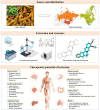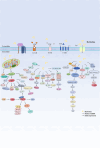Pharmacological properties and therapeutic potential of berberine: a comprehensive review
- PMID: 40894216
- PMCID: PMC12391081
- DOI: 10.3389/fphar.2025.1604071
Pharmacological properties and therapeutic potential of berberine: a comprehensive review
Abstract
In recent decades, the pharmacological properties of botanical drugs have been investigated with increasing depth, offering novel insights into their potential for enhancing healthcare. Berberine (BBR) is an alkaloid extracted from the roots, rhizomes and stem tubers of plants such as Coptis chinensis, Phellodendron amurense, Radix berberidis, and several other plants, which is used not only as an anti-inflammatory and antibacterial agent, but also for the treatment of cancer and chronic diseases. BBR has demonstrated remarkable therapeutic efficacy in the management of disorders affecting the nervous, cardiovascular, and endocrine systems, characterized by its high safety profile and minimal adverse effects. Despite the substantial progress made in understanding BBR's pharmacodynamics, its precise mechanisms of action remain incompletely elucidated and warrant further systematic investigation. This study provides an extensive review of the latest pharmacological findings related to berberine and its therapeutic advancements, offering strong evidence for future research and clinical implementation.
Keywords: application prospects; berberine; pharmacodynamics; pharmacological properties; therapeutic potential.
Copyright © 2025 Fan, Zhang, Song, Zhang, Chen, Cheng, Su, Zou, Yu, Tan, Xu and Yan.
Conflict of interest statement
The authors declare that the research was conducted in the absence of any commercial or financial relationships that could be construed as a potential conflict of interest.
Figures








References
Publication types
LinkOut - more resources
Full Text Sources

